Some (most) elements will not work without it!
A Briefing Paper
by
The Association of RAF Fighter Control Officers
The D-Day Fighter Control Story
Compiled and Edited
By
Group Captain Tim Willbond RAF (Retd)
Acknowledgement
This paper has been compiled from a number of sources. Squadron Leader Mike Dean and Mr Peter Best generously provided information and advice and a special debt is owed to Doctor Les Dobinson for his advice and contribution which was special because he was there. Some facts have been taken from Government sources and under the terms of the standard Open Government Licence we would like to acknowledge the importance of Air Publications 1063, 3237 and 1116 that were produced by the Air Historical Branch in the 1950s
This document is not for sale and has been compiled for use by the Association of RAF Fighter Control Officers and the RAF. The document may be used for wider research purposes but material contained herein may not be reproduced without the approval of the providers of the source material.
Fighter Control During the Assault Phase of Operation Neptune - 6th June 1944
Introduction
By 1944 there was a wider understanding amongst the air planners that control of the air was a primary responsibility for the air force. Experience gained in the Battle of Britain, the Western Desert and Mediterranean had shown that success in controlling the air was dependent upon a system of command and control that used radar to provide warning of attack and a tactical picture of the airspace for battle management and weapons control. Surveillance using radar prevented the enemy air mounting surprise attacks and with intelligent battle management could be used to surprise the enemy. Moreover, the lessons from the North Africa had also shown the value of radar cover beyond the front line to help both direct and protect offensive air operations.
The section of the French Coast selected for Operation Neptune, which was the code name for the assault phase for the liberation of Europe otherwise generally known as D- Day, was over 80 miles from the English coast. South coast radar units could provide some cover over the beaches but the advanced warning of enemy air approaching the beaches was insufficient to ensure control of the air. It was necessary, therefore, to extend the coverage for both picture compilation and tactical control and to establish ashore, at the earliest possible time, mobile tactical air control units to control and defend the air above the bridgehead.
Once again experience from the Mediterranean, especially Operation Husky, the invasion of Sicily, had thrown up many valuable lessons one of these was that units providing control of the air and the control of offensive operations as part of a composite RAF Group working alongside the advanced elements of the Army could not also provide picture compilation and the control of day and night fighters in the base areas and behind the front line.
Another lesson was that picture compilation, which included the track analysis (known as filtering) and the track identification processes, should be collocated with the composite Groups’ operations centres and so these two operational capabilities were combined into one Group Control Centre (GCC). Prior to this the picture had been constructed and maintained by a separate Mobile Raid Reporting Unit (MRRU).
Air Organisation for Operation Neptune and Overlord
All RAF and US air forces assigned to operation Overlord – the liberation of Europe - were placed under the command of the Commander-in-Chief Allied Expeditionary Air Force (AEAF) with the RAF managing all air operations in the British area of responsibility and the USAAF managing air operations in the US area of responsibility.
In the UK area the plan was that No 85 Group would provide air defence behind the front line and especially all the base areas. The Second Tactical Air Force (2ATAF) was to prosecute the forward air battle including close air support to the army and it comprised two composite Fighter and Fighter Bombers Groups, Numbers 83 and 84 Groups, and a Medium Bomber Group - No 2 Group. Surveillance and control units providing air surveillance and tactical control were assigned to Numbers 83 and 84 Groups.
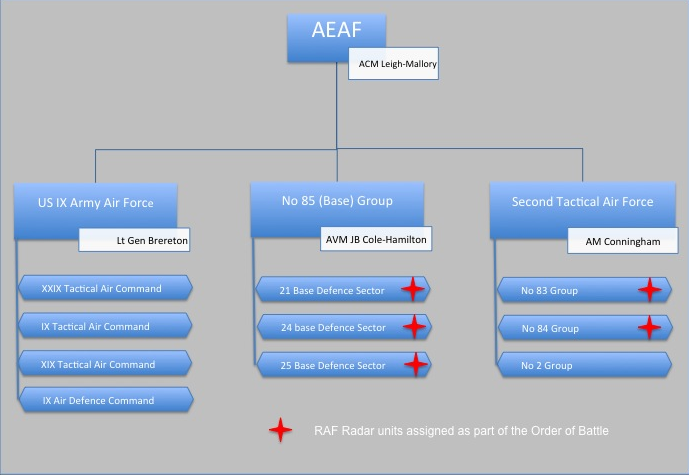
Figure 1 - AEAF Organisation
The forward battle was fluid and control of both offensive and defensive air did not lend itself to the structure that had been established for the defence of UK airspace. However, the defence of the base areas was modelled more on the UK system and under the Group Commander three base Defence Sectors were established. The organisation is shown at Figure 1.
Operation Neptune
Operation Neptune covered the assault phase and was all about establishing a firm bridgehead ashore by D-Day plus 1. The responsibility for the defence of the air for Neptune was vested in the Commander-in-Chief of Air Defence of Great Britain (ADGB), formally Fighter Command, which was based at RAF Bentley Priory. The AOC in C delegated the operational control of air forces to undertake the task to AOC 11 Group. The challenge for the air surveillance and control system was to provide adequate forward cover and the seamless transfer of control of the air to 85 Group units; this group was to deploy the first tactical control units over the beaches.
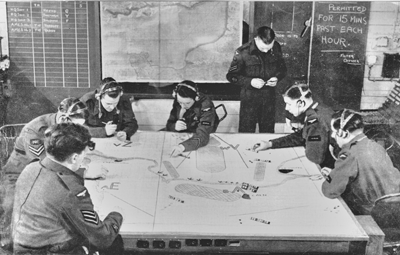
Figure 2 - FDT Filter Table
Courtesy of Mike Dean
The plan that was formulated required a total of 3 Landing Ships Tank (LST) to be converted as air surveillance and control ships; these were designated as Fighter Direction Tenders (FDT). The interesting point is that the FDTs, in addition to early warning and control, also undertook the full picture compilation role with their own Filter Centres and Identification teams. A picture of a Filter Centre in a FDT is shown at Figure 2. The FDTs were Royal Navy units under the command of the Allied Naval Commander of the expeditionary naval forces but were operationally controlled by AOC 11 Group.
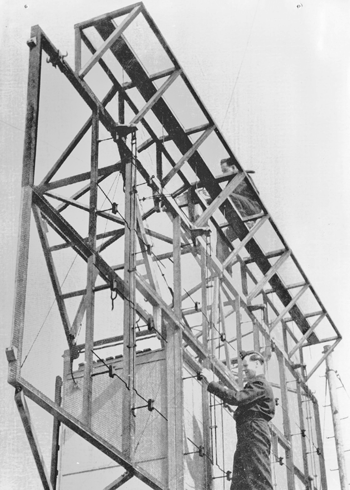
Figure 3 - Type 15 Aerial on a FDT
Courtesy of Mike Dean
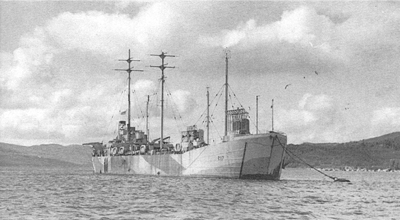
Figure 4 - FDT 217
The concept of using ship borne RAF radar equipment for surveillance and control was first trialled in North Africa and then used during Operation Husky when LST 305 was fitted with Ground Control Interception (GCI) radar (the Type 8 then used by GCI units in the Mediterranean at the time), control equipment and radios. The D-Day FDTs were equipped with the Type 15 and the Type 11 radars both fitted with Mark III IFF interrogators/responders, Aircraft Interception beacons and VHF radio telephony and wireless telegraphy sets. The term GCI was a rather interchangeable term that was used to denote radars that could be used for close controlled interceptions but also for those which were primarily control units although they also had an early warning and surveillance role. The FDT system proved so successful the AOC-in-C Fighter Command pressed for 4 FDTs to support Operation Neptune. Three were produced:

Figure 5 - FDT 13
-
No 216 FDT. This FDT was positioned seaward of the US beaches in the western half of the assault area. Its role was to produce a tactical picture over the US area, provide raid reporting and to control both RAF and USAAF fighters tasked to operate in the area.
-
No 217 FDT. This FDT was positioned seaward of the British beaches in the eastern half of the assault area to undertake the same role as FDT 216. However the ship was designated as the main coordinating FDT or Master Control FDT; the senior RAF controller was aboard this ship. The Master Control FDT had the additional role of managing fighter resources across the whole assault area.
-
No 13 FDT. This FDT was positioned in the main shipping route to provide defensive cover over the shipping lanes.
The FDT positioning in relation to the air corridors, shipping lanes and assault beaches is shown at Figure 6 below.

Figure 6 - Air Surveillance and Control D-Day
There was one problem with the organisation and that was very much tied to inter-Service politics. The Royal Navy was in command of the sea forces during Operation Neptune and the HQ ships were earmarked for each assault beach. It was deemed necessary for the HQ ships to issue air raid warnings and to exercise Anti-Air Artillery fire control; in one respect this was sensible because they were well equipped with radio telephony sets. However, the main problem was that telling the information to the HQ ships built in delays and on more than one occasion air raid warnings were issued as the raid was taking place. It was commented upon in the Air Historical Branch analysis that it would have been more efficient for the FDTs to issue the air raid warnings.
The next challenge was to establish a comprehensive air surveillance and control capability ashore and to do this 2 ‘GCI units’ from 85 (Base) Group were assigned to land on the beaches on D-Day. Number 15082 GCI with its attached Mobile Signals Unit (MSU) and an additional Light Warning Set (LWS) radar for forward gap filling along with elements of 21 Base Sector was tasked to land on Omaha beach in the American area at about 1200hours to provide surveillance and night fighter cover. Number 15083 GCI, also with an additional LWS and an assigned MSU, was tasked to land with elements of 24 Base Sector on Gold beach in the British sector also at about 1200hours. In addition, advanced elements of 483 GCC were also to land on Gold beach. Personnel who served on the mobile radar units received combined operations commando style training to help them to survive and operate in combat field conditions. The level of training they received can be illustrated by the actions of Flight Sergeant Muir Adair. He landed in an LCT that was separated from the main body of 15082 GCI personnel. He gathered a number of personnel from various units, services and nationalities and organised them into an ad-hoc platoon that he then led in an assault on, and the clearing of, German positions from an orchard that stood between him and his Unit.
The RAF deployed beach parties on D-Day that included barrage balloon units and there were some RAF Regiment and other signals personnel; however, the only major operational units to cross the beaches on D-Day were Numbers 15082 and 15083 GCI Units with their attached LWS and MSU formations.
Into Battle
Fighter Direction Tenders (FDTs)
After a delay of 24hours caused by bad weather, the FDTs sailed at 2200hours on the 5th June in very poor sea conditions. However, the sea state moderated and the FDTs arrived at their respective positions around 0430hours. To achieve surprise, the assault force approached the beaches under complete radio silence. All the FDTs switched on their radars at H Hour, 0725hours, and immediately took control of the fighter aircraft providing the defensive air umbrella.
A total of 9 Spitfire and Thunderbolt Squadrons provided air cover over the assault area during daylight hours. These Squadrons were under the control of FDT 216 and FDT 217. Four USAAF Lightning Squadrons controlled the air over the shipping route and approach to the assault area and these were under the control of FDT 13. In addition, a total of 38 night-fighter aircraft were controlled by the FDTs during the night of 6/7th June. The large number of friendly aircraft in the area combined with the dropping of 'window' by friendly bombers presented Filter Room personnel with a very challenging and busy time in compiling the air picture.
On the first evening the Luftwaffe carried out a bombing raid on the British beaches, resulting in casualties but no serious damage to shipping and stores. FDT 217 detected and identified the raid but it was quickly lost in the numerous echoes from the concentration of shipping and permanent echoes from the coastline. FW190 and ME 109 fighter-bombers subjected the beachhead area to sporadic attacks during poor weather or low cloud cover. There were also a number of JU88 raids at dusk. It was estimated that enemy air activity resulted in 30 - 40 sorties a night. FDT 13 saw little action because the shipping lanes were not subjected to enemy attack.
FDT 13 returned to port on 13th June for re-supply and on the 15th June FDT 217 replaced FDT 216 off the American beaches because 15082 GCI was still not fully operational. FDT 216 returned to port for repair to damage suffered in a collision. FDT 13 returned to a station North East of Barfleur to counter enemy nighttime mine laying. On the 23rd June, FDT 217 was withdrawn from the American sector after 17 days of continuous operations.
On 27th June, FDT 216 replaced FDT 13 off Barfleur; the shore-based GCI in the Barfleur area came into the line on 1st July and FDT 216 was moved to a position 23 miles West of Le Havre to defend against enemy mine laying aircraft.

Figure 7 - Drawing of sinking. Found in the National Archives and
probably made as part of the Royal Naval report on the sinking
At 0100hours on the 7th July a single JU88 penetrated the defensive screen and, despite efforts to destroy or force the aircraft to deviate from its attack run by gunfire, attacked FDT 216 with a torpedo that struck the ship on the port bow. The report by Lieutenant Commander GD Kelly, the commanding officer of FDT 216, stated "One torpedo was seen to splash about 1/2 mile on the port beam, and the track was seen approaching the ship, at first I had hopes it was going to clear us." At 0059hours the FDT was hit with a great explosion, a subsequent explosion ripped a hole in the ship's side and smoke and flame blew out the elevator hatch up to mast height. The abandon ship order was given at 0107hours and the ship turned over at 0145hours. The escorting Corvette HMS Burdock went to the LCT's aid and had rescued the survivors by 0245hours. Amazingly, out of a total complement of some 90 RN personnel, 19 RAF Officers, 155 other ranks and the ship’s dog, only 5 airmen lost their lives; these men are remembered at Runnymeade. The ship’s gunner on HMS Burdock was Mentioned in Dispatches for his part in this action.
Continuous employment on a 'watch and watch' basis of 4 hours on and 4 hours off, in poor working conditions, imposed a very serious strain on the personnel. The radar personnel had been on these vessels for 5 months, living in cramped accommodation intended only for tank crews on short transit trips.
-
There was no air conditioning and the work areas were overcrowded. With a lack of exits, they were widely considered to be "floating death traps".
-
No criticism could be found with the radar equipment. It worked efficiently and was never taken off the air for maintenance during the operation.
-
The rigid procedures used in the selection of officers and men to staff the FDTs proved to be justified by the way they all worked together under very adverse conditions. They indeed were worthy of high praise.
Overall the FDTs performed extremely well in trying conditions and were worked near to capacity for the whole time they were off the beaches. The results achieved by the FDTs during the period from 6 -26 June 1944 are as follows:
-
Day Time
- FDT 13 - Nil
- FDT 216 - 13
- FDT 217 - 39
-
At Night
- Night Fighters controlled - 419
- Number of Contacts - 380
- Visual identification of friendly aircraft intercepted - 267
- Enemy aircraft destroyed 24 and two probable.
Assault Over The Beaches

Figure 8 - 15083 GCI landing on Gold Beach
Photograph Courtesy of Mike Dean
Number 15083 GCI - The British Sector. Number 15083 GCI, commanded by Squadron Leader RH McCall, and their associated LWS and telecommunications units embarked on the 3rd June in 5 Landing Crafts Tank (LCTs) and spent 2 very uncomfortable days at sea in rough conditions. They eventually landed between 1530 - 1640hours over Gold - King Red sector - beach on the 6th June. The LCT was well handled and the convoy disembarked in about 2' 4" of water; 2' 6" was the maximum that some vehicles could handle. The exception was a jeep that led off from the 2nd LCT containing 2 Wing Commanders from the advanced element of 83 Group Headquarters. One was arguably the first Fighter Control ace with over 100 kills to his name - Wing Commander John Laurance Brown; the other was Wing Commander Mawhood who was also a very successful controller. Their jeep went into a depression in the sand and at one stage only their heads and shoulders were visible above the water. It was reported that the amusement caused did much to ease tension.
The convoy disembarked without loss but its exit from the beach was delayed because of the weight of traffic. Once clear of the beach, the convoy quickly found its earmarked site at Meuvaines that was occupied by many tanks and the enemy was in a wood close by; the tank commander advised that they may have to fire over the site. Notwithstanding, Squadron Leader McCall was clear about his orders and set about establishing the Unit on the site. After organizing the grass to be cut to prevent tanks running over vital cables, the Unit was set up very quickly and was operational by about 2230hours in the surveillance role; however, there were a number of technical challenges and only one control position was initially available. That said, the Unit controlled its first night fighter shortly before midnight on the 6th June and the second position became available shortly after midnight. The MSU allotted to 15083 GCI landed on a different beach and was pinned down until an enemy strong point was liquidated. It reached the 15083 GCI location at dusk on D-Day+1; from this point 15083 GCI became fully operational providing air defence over the British beaches and the sea approaches to the beaches.
Although FDT 217 was the Master Control Unit, 15083 GCI took over the coordination of the night battle in the British sector on 8th June and subsequently handed over this responsibility to 24 Base Defence Sector Operations Centre on D-Day+6.
The work of Light Warning Unit (LWU) 6091 is worthy of note. It was acting as forward cover for 15083 GCI and was moved each night to a ridge overlooking the River Orne; the Unit had been augmented with the addition of a controller to provide a control capability. It operated well forward under enemy fire and took a number of casualties including one controller killed. Nonetheless, it maintained cover at night over a vital sector and 9 enemy aircraft were destroyed under its control.
Flight Lieutenant Geoffrey Adams Harper RCAF, was the unit's Radar Officer and much of the credit for the rapid deployment and achieving an operational status by 2300hours was due to his efforts. He was Mentioned in Dispatches and was also subsequently awarded the Croix de Guerre.
Number 15082 GCI - The American Sector. The contrast between the landing of 15083 GCI and 15082 GCI could not have been greater. Number 15082 GCI, attached LWU and MSU along with elements of 21 Base Defence Sector were all under the operational control of Wing Commander Anderson who was the senior officer from 21 Base Sector to land that day. Anderson was subsequently wounded and evacuated.
No 15082 GCI was under the command of Squadron Leader FJ Trollope which had embarked in 5 LCTs at Portland on 2nd June, setting sail on the 4th June only to return to harbour when the landings were delayed. The convoy sailed again at 0430hours on the following morning and was positioned off the coast of Normandy soon after dawn on the 6th June.
The first attempt to land on Omaha beach was made at 1130hours but the beach was still under dense enemy fire and there was just not enough room because of the mass of corpses, wounded and wreckage and so it was decided to delay the landing. By late afternoon the beach defences were still being subjected to considerable suppressing fire from the Royal Navy but the RAF convoy was directed to land at St Laurent whatever the outcome. This was about a mile west from the originally planned landing point at Colleville-sur-Mer.
As the convoy drew near the coast it became apparent that the beach was still under direct fire from German 88mm guns, deeply laden with American dead and wounded, littered with damaged vehicles and landing craft and both exits from the beach were blocked; nevertheless, the landing went ahead.

Figure 9 - 15082 GCI Destroyed Convoy Vehicles Omaha Beach
Photographic credit - No 80-G-45714 in the US National Archives
Four of the LCTs manoeuvred such that the landings took place in about 4 feet of water which was really much too deep for the vehicles. On disembarkation, several vehicles encountered even deeper water caused by shell holes and were almost totally submerged and had to be abandoned.
LCT 649, the 5th landing craft, grounded on a sandbank a long way off the beach but registered 4 feet of water at the ramp; unfortunately, as the vehicles moved forward they quickly submerged into over 6 feet of water and all the vehicles, bar one which would not start, were 'drowned'. Despite a long swim to the beach all personnel made it ashore without loss of life. Of the 27 vehicles that disembarked, only 8 were driven off the beach. The remaining 19 vehicles were either 'drowned', disabled or destroyed by 88mm German gunfire.
The beach was sustaining heavy and continuous fire and unit personnel temporarily dug slit trenches at the top of the beach in shingle until a safer place could be found. After a gallant reconnaissance by the Padre, Squadron Leader The Reverend C Harding, during which he secured a container of water for the wounded from a house still occupied by the enemy, Squadron Leader Trollope gathered his surviving personnel who were dispersed along the top of the beach and moved them to a safer place at the western end identified by the Padre. For the next few hours Unit personnel were engaged in salvaging as much equipment as possible and helping move casualties, mostly American troops, to safety. For some 48 hours the Unit Medical Officer, Flight Lieutenant RN Rycroft, attended the wounded, assisted by Medical Orderly, Leading Aircraftman John Reid, and the Padre who also gave succour to the dying. Those capable of doing so buried their RAF dead and moved to less exposed locations. Flight Lieutenant Rycroft is recorded as having given aid to 75 American troops whose immediate medical aid teams had been all but wiped out and Leading Aircraftman Reid was credited with treating more than 100. Rycroft, Harding and Reid carried out their duties under direct fire with limited equipment and both Rycroft and Harding were slightly wounded.
Whilst Squadron Leader Trollope was organizing a move off the beach his Senior Technical Officer, Acting Squadron Leader N Best, with a small team were salvaging equipment from whole vehicles to small pieces of serviceable equipment from the beach under constant fire. By the end of the 7th June, Acting Squadron Leader Best advised Squadron Leader Trollope that they had enough equipment to achieve a limited operational capability - a remarkable achievement.
The original designated operations site was still in enemy hands. After consultation with US General Timberlake, the only senior officer with whom they were in contact, a new site was selected at Point-du-Hoc. The Unit was ready to become operational on the evening of the 9th June but because the bridgehead was now some 8 miles deep they received orders to move. The unit immediately packed–up but became operational in time to control during the evening of the 10th and claimed one enemy aircraft destroyed and one probably destroyed that evening. It is, indeed, fortunate that enemy air attacks were much lighter than expected and the ‘Master Control’ FDT 217 was able to provide sufficient cover until 15082 GCI became operational on D-Day+4, a replacement Receiver vehicle having been landed on D-Day+3.
An interesting postscript is that the elaborate beach organisation that should have been in place to ensure speedy disembarkation, keep the beach exits clear and generally manage events had not landed because it was deemed too dangerous!
Number 15082 GCI received a severe mauling during the landings and the total casualties amongst its personnel were as follows:
- Killed - 1 Officer, 9 Other Ranks
- Missing - 1 Other Rank
- Wounded - 5 Officers, 31 Other Ranks – one of whom died later
There were some 10,386 Military Crosses (MCs) awarded for gallantry to officers of all 3 Services during the whole of World War Two and of this number only 69 MCs were awarded to RAF officers. It is, therefore, quite remarkable that from this small number, 4 were awarded to officers of 15082 GCI on D-Day. In addition, a further 2 Military Medals were awarded to Other Ranks of 15082 GCI and these are probably even rarer than the MCs. Even rarer still is the award of the Croix de Guerre to Flight Sergeant Muir Adair of the RCAF. An interesting side note is that the 2 Croix de Guerres awarded on D-Day to RCAF radar personnel are unique within the RCAF. This is a seriously impressive total of gallantry awards and a suitable recognition of the way the Unit fought its way off the beaches and established an operational capability so quickly after losing so much of its equipment and men. The full Roll of Honour for Number 15082 GCI is depicted below. The Unit went on to serve in France until September during which time it is reported that it achieved the destruction of 50 enemy aircraft of which Squadron Leader Trollope is credited with 13 enemy aircraft destroyed.
Conclusion
The significance of the contribution and achievements of the personnel and units of the then Control and Reporting (C&R) organisation, now the Airspace Surveillance and Control [ASAC] organisation, as a key component of Orders of Battle across all theatres of operation during World War Two, has not always received the recognition that it merits. Most significantly, the operational contribution made by personnel and units of the C&R organisation to the success of D-Day has received scant recognition. The fact that a GCI Unit was landed over Omaha beach to provide air defence over the US beaches and that so many awards for gallantry were made to the Unit should be much more widely recognised and acknowledged, as, indeed, should the remarkable achievements of the FDTs and 15083 GCI.
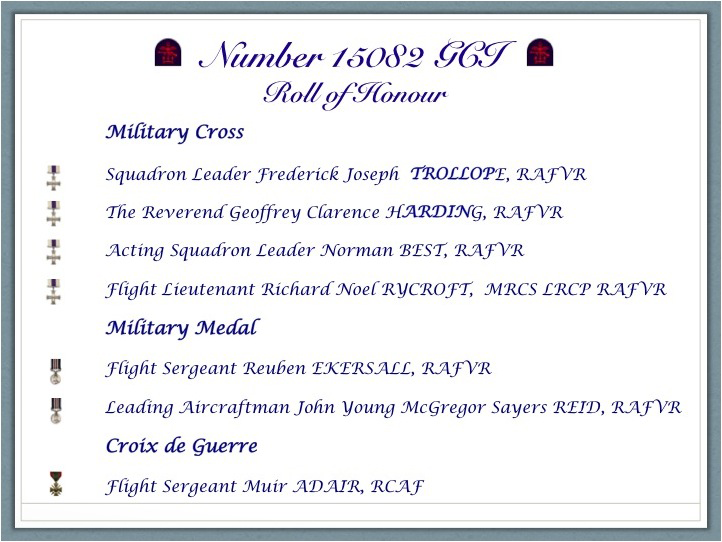
Roll of Honour No 15082 GCI
A significant contribution to remedying the widespread oversight of the important role served by the Mobile Signals and Radar Units of the Second Tactial Air Force, from D-Day throughout the Battle of Normandy, and subsequently through Belgium and Holland into Germany, has recently been made by the erection, on the approach to Omaha Beach, of a memorial dedicated to the memory of those GCI personnel who gave their lives there on D-Day. The Memorial was unveiled by the British Defence Attaché and dedicated by the RAF Staff Chaplain on the 68th Anniversary of D-Day in 2012. The moving force behind the creation of this memorial was Doctor Les Dobinson.